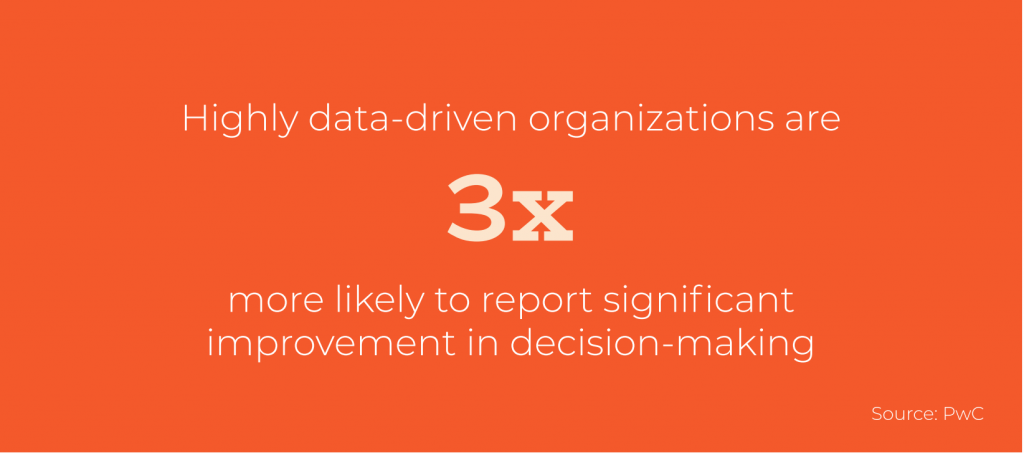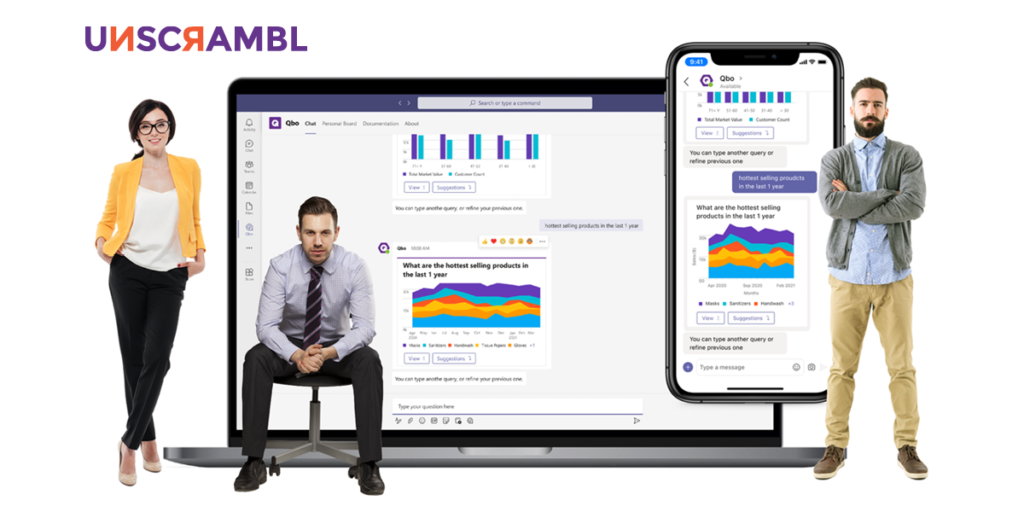 7 Minutes
7 Minutes

7 Steps to Foster a Data-Driven Culture for Your Organization
As we move more towards an increasingly interconnected world, businesses are facing a host of challenges to address, opportunities to seize and customers to please.
From the continuous evolution of changing consumer behavior to the commercial disruption of businesses from the COVID-19 pandemic, companies have been embracing data & recognize it as the fuel for innovation to stay competitive.
While teams of data analysts have been assembled, together with huge investments in data infrastructure and analytical solutions, effective and consistent data-driven decision-making still eludes even the best of firms.
Business Intelligence Provides Answers but It’s People That Drive Change
An increasing number of companies are adopting data solutions such as business intelligence, however, the majority of employees in these organizations aren’t reaping the benefits in their everyday work.
According to a survey conducted, the median business intelligence software penetration rate ranges from only 6% to 17% across an organization.
This means companies won’t be able to maximize the full potential of their data analytics capabilities. Additionally, organizations might also experience disparate decision-making – whereby one decision might be made in a data-driven manner, while another might just be an opinion from an authority figure.
While companies can mandate the use of data and analytics solutions in the daily work of employees and teams, a lasting solution, as Gartner highlights, is to influence mindsets and incentivize behaviors throughout the organization holistically.
Establishing a Data-driven Culture Is Key for Business Innovation
Creating a data-driven culture is a challenge that many organizations have to face.
However, the payoff of being data-driven is one of increased business competitiveness, optimized organizational efficiency, and commercial innovation to stay ahead of the curve.

In fact, a study conducted by PWC that surveyed over 1,000 senior management executives reported that highly data-driven organizations are 3x more likely to report significant improvements in their decision-making versus those that weren’t. Google is one such corporation that has fully embraced a data-driven culture and is effectively utilizing it to enhance its workforce through ‘people analytics’.
By using data in their recruitment and talent management decision-making, Google effectively saw tangible results such as reducing new mother attrition rates by 50% through extending maternity leave, allowing the company to care for both their employees and their bottom line.
To help companies better foster a data-driven culture and reap the benefits of better decision-making, we have developed a 7-step roadmap that you can use to build one from the ground up.
How to Create a Data-driven Culture: A 7-step Roadmap
A data-driven culture not only understands and values the use of data in decision-making, it also embraces a culture of innovation and spurs meaningful conversations across departments.
Let’s dive deep into actionable steps every organization can take to foster an environment where the power of data can be effectively harnessed by everyone.
1. Get Executive Buy-in from the Leadership Team
Great companies lead by example from the top, and to build a data-driven culture, you will need business leaders in your organization to support and get actively involved in it.
A good start is to initiate conversations led by your chief data officer (CDO) with key stakeholders in your organization.
This can be done by articulating the business value a data-driven culture can deliver to each department as well as how the current style of decision making will change with data being brought forth into the conversation.
Leaders will have to understand that a data-driven culture goes beyond using data to justify a decision but using it as the main driver to make a decision.
This will allow leaders to better organize their business units to allow smoother collaborations throughout the organization between the different departments.
2. Conduct Data Literacy Sessions
While business teams are great in what they do, understanding and utilizing data is most probably completely foreign to them.
Through executive sponsorship and department leaders championing the push towards a data-driven culture, departments can start to conduct data literacy sessions and workshops.
Data scientists can be empowered to lead conversations and workshops to help educate employees on how to read, understand and process data that they will encounter during their daily tasks.
Organizations can also, in fact, can rotate their data specialists across the various departments to break down barriers between the IT department and commercial units of the business. This helps to foster an environment of trust and collaboration
Additionally, departments can develop specific curriculum that is tailored to the unique needs of their department.
One example is taking sales teams through the various key data being generated throughout the company and framing them in a context that directly affects metrics that matters to them – such as leads generated or customer retention.
3. Enable Data Democratization Throughout the Organization
A data-driven culture is one where all executives, from the boardroom to the frontline, can easily access the data they need to make better decisions.
Having siloed data discourages end-users from actively seeking out the data they want as well as burdens data analysts with additional work that slows down productivity.
Thankfully, the challenge of data democratization can be easily solved by utilizing an intuitive business intelligence platform that is powered by conversational analytics.
This means by simply asking questions to the data like how you would in a natural conversation, teams will be able to access disparate data from anywhere in the organization and gain insights (or simply pull out the data) in a matter of seconds.
Organizations will have to go beyond search-based or self-service BI dashboards and empower each individual in the organization with a tool that simplifies the complex while being highly convenient.
4. Create a Positive Feedback-loop with Quick Wins
Quick wins are an excellent change-management strategy that can help organizations ease into embracing a data-driven culture, especially if there has been a precedent of ‘doing things the old way’.
People in your organization, from key management figures to ground-level staff, need to see tangible results that impact the company as well as their own personal or departmental KPIs.
A great way to accomplish this is to identify a small metric in your organization that is underperforming and utilizing data-driven decisions to optimize the processes driving it.
For example, if it is the meeting close rate of the telesales department, business intelligence can be used to optimize key variables, such as the timing of the calls, to improve the KPI.
By going for quick wins, organizations will be able to create a positive feedback loop, proving to everyone that a data-driven approach drives results and to continuously make more data-driven decisions.
This allows companies to build and ride the power of momentum to drive lasting change to the existing culture.
5. Use Data to Drive Positive Change for Employees & The Community
While the end goal of a data-driven culture is to drive business results, employees are the life-blood of any company, and getting each individual’s support is critical for long-term success.
A smart organization will utilize data to help improve employee working conditions, morale, and benefits.
This can be done through a committee analyzing data to improve engagement with their employees or empowering individuals to gain insights themselves on their daily tasks.
Through the democratization of data, employees can be encouraged to find more productive or alternate routes of doing things – backed up by data of course. This allows teams to relate the use of data with making their own individual working-lives better, fostering a better relationship with data.
Data can also be used by organizations to help communities and humanitarian efforts, like how Facebook utilized their data to create disaster maps, helping to address critical information gaps rescuers face when responding to a natural disaster.
Employees will be able to appreciate that their use of data can make a positive impact in the world that goes beyond the organization and themselves.
6. Establish a Set of Organizational Goals to Work Towards
One common barrier to the adoption of a data-driven culture understanding where to start with data and how to effectively utilize it.
To address this, business leaders can establish a set of unified organizational goals which will be broken down into key metrics where employees can channel their efforts towards.
By breaking down big goals into smaller metrics, allows teams to focus their data analysis and decisions. Allowing results to manifest faster and steer employees in the right direction.
This is important as it helps to foster a sense of progression and accomplishment across the organization and helps to transform disparate teams of employees into a tribal community.
This lets every employee feel they have made a tangible contribution to the bigger picture and helps associate adopting a data-driven culture with doing their part.
7. Encourage Teams & Leaders to Explain Their Decisions Analytically
In a data-driven culture, conversations about data should be commonplace throughout any decision-making process.
To encourage this, business leaders can spearhead the effort to begin explaining key decisions made analytically – backed up by data that everyone can access.
This helps to showcase accountability at the highest levels on how decisions are made and that a data-driven approach is being actively taken, especially on decisions that could affect the entire company.
By taking employees and stakeholders through how a challenge is approached analytically and how the final decision is made with data-driven insights, business teams will be able to learn and adopt an effective framework on how to better utilize the data they have on hand.
Companies can also take things one step further by involving teams in the decision-making process with data being at the forefront of the conversation to further build the organization’s data-driven culture and increase employee engagement.

Establish A Data-Driven Culture For Your Organization Today
While every company aspires to utilize data to make better decisions consistently, many fall short due to old habits or not having a clear plan of shaking up old decision-making processes.
To ingrain a data-driven culture to an organization’s DNA, business leaders must take a step-by-step approach to win the hearts and minds of everyone and that’s where our roadmap can help.
At Unscrambl, we have developed qbo, a business intelligence tool powered by conversational analytics, allowing your organization to access and gain insights into your data by simply asking questions.
Embark on a free 14-day trial today and unlock the full potential of a data-driven culture for your company.


